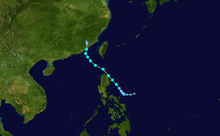Tropical Storm Cimaron (2013)
| Tropical storm (JMA scale) | |
|---|---|
| Tropical storm (JTWC scale) | |
 Tropical Storm Cimaron on July 17 | |
| Formed | July 15, 2013 |
| Dissipated | July 18, 2013 |
| Highest winds |
10-minute sustained: 75 km/h (45 mph) 1-minute sustained: 75 km/h (45 mph) |
| Lowest pressure | 1000 mbar (hPa); 29.53 inHg |
| Fatalities | 6 total[1] |
| Damage | $325 million (2013 USD) |
| Areas affected | |
| Part of the 2013 Pacific typhoon season | |
Tropical Storm Cimaron, known in the Philippines as Tropical Storm Isang, was a weak tropical storm, with only a pressure of 1000 hectopascals and 45 mph, it formed and made landfall in the Philippines, especially Luzon, and China, as well as affecting Southern Taiwan during its nearby passage. Despite being weak, the storm still caused extensive damage amounting to approximately $325 million in China, as well as 6 deaths in total, with 2 in the Philippines.[1]
Meteorological history

In late July 14, a tropical low was formed near Eastern Luzon, as it was gradually moving eastward, the tropical low's deep convection started to wrap around forming a better defined circulation. Still as a tropical depression, finally on July 16, a tropical depression generated over the western North Pacific to the east of the Luzon Island of the Philippines. The Joint Typhoon Warning Center (JTWC) categorized the depression as 08W, and the Philippine Atmospheric, Geophysical and Astronomical Services Administration (PAGASA) promptly named it the Philippine name Isang.[2] As the tropical cyclone which will soon become Cimaron, was currently moving northeastward, still as a tropical depression, it made landfall in Northern Luzon at the same intensity. Many raindrops fell from the sky while thunderstorms spread around the area. A strike of lightning spawned and struck the province of Ilocos Sur, killing 2 people and leaving an extra 2 more injured.[3] After its landfall in the Philippines, the cyclone entered the Bashi Channel. As it did, it also entered conducive conditions. Due to the favorable ocean conditions, the cyclone's intensity was upgraded to tropical storm status. Simultaneously, it was named Cimaron (1308) by the JMA on early July 17.[4] Cimaron continued to move northwest and entered the northeastern South China Sea, where it affected areas of Taiwan, but no fatalities, injuries, or any missing people where reported around that area. It afterwards began to turn towards the north and approached the south coast of Fujian. It finally made its last landfall as a weak tropical storm of the Zhangpu County on the date of July 18, with the maximum wind speed at its center reaching at least 45 mph at its landfall. After landfall, Cimaron continued to move in a northwestern direction, with its intensity decreasing very rapidly, and it weakened into a tropical depression within Fujian on July 18. The Japan Meteorological Agency stopped monitoring the storm at 21:00 UTC on July 18, as it was declared it had dissipated by then.
Preparations and impact

300,000 people were evacuated due to safety.[5] As previously mentioned, a lightning incident occurred in the Philippines killing 2 people. 20 million people were affected by the cyclone, and approximately 9 million people were relocated around the landfall area. An intense and unusual thunderstorm by the cyclone produced 406 lightning strikes in under 2 hours in Xiamen.[6]
Aftermath
Many torrential rains cascaded down to land in Fujian. In 24 hours, a peak of 505.3 mm (19.89 in) was measured in Mei Village, with an hourly maximum of 132.3 mm (5.21 in).[7] Many roads were flooded and houses damaged due to Cimaron's passage.[8] Areas near Cimaron's landfall had experienced flooding that can happen once in every 500 years. Many powers lines were cut, as well as houses were also destroyed.
See also
- Typhoon Megi (2010)
- Typhoon Fitow (2013)
- Tropical Storm Linfa (2009)
- Typhoon Soulik (2013)
- Typhoon Haikui
- Typhoon Morakot
- Tropical Storm Morakot (2003)
References
- ↑ 1.0 1.1 "Member Report (2013)" (PDF). typhooncommittee. p. 53. Retrieved December 8, 2013.
- ↑ "Several Luzon provinces under Signal No. 1 as tropical depression ‘Isang’ intensifies". Frances Mangosing. Retrieved December 8, 2013.
- ↑ "SitRep No. 3 re Effects and Actions Taken in Response to TS Isang" (PDF). July 17, 2013. Retrieved December 3, 2013.
- ↑ "TRMM Sees Strong Tropical Storm Cimaron". Retrieved July 19, 2013.
- ↑ "Severe weather across eastern Asia". July 20, 2013. Retrieved December 8, 2013.
- ↑ 台风"西马仑"致厦门一晚闪电406次 (in Chinese). Sohu.com Incorporated. July 20, 2013. Retrieved October 1, 2013.
- ↑ "西马仑"横扫福建 雨势猛烈开车如开船 (in Chinese). Sina Corp. July 19, 2013. Retrieved October 1, 2013.
- ↑ 闽南地区受热带风暴"西马仑"影响发生特大暴雨 (in Chinese). 新华网. July 20, 2013. Retrieved October 1, 2013.
External links
| Wikimedia Commons has media related to Tropical Storm Cimaron (2013). |
- JMA General Information of Tropical Storm Cimaron (1308) from Digital Typhoon
- JMA Best Track Data of Tropical Storm Cimaron (1308) (Japanese)
- JTWC Best Track Data of Tropical Storm 08W (Cimaron)
- 08W.CIMARON from the U.S. Naval Research Laboratory
| ||||||||||||||||||||||||||||||||||||||||||||||||||||||||||||||||||||||||||||||||||||||||||||||||||||||||||||||||||||||||||||||||||||||||||||||||||||||||||||||||||||||||||||||
